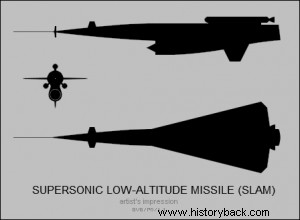
The "Wealth Program" was one of many plans developed during the Cold War aimed at annihilating the adversary. The goal was to develop a flying vehicle-missile "drone" that would fly for a very long time propelled by a thruster-type engine powered by a nuclear reactor.
In early 1957 the US Air Force commissioned the Lawrence Radiation Laboratory to study the construction of a nuclear-heated thruster. The flutter – an engine similar to that of the German V-1 flying bomb of World War II – works by taking in air which is heated and exits at high speed from the nozzle of the rocket carrier.
The nuclear reactor of what was called a Supersonic Low Altitude Missile (SLAM) it had to be small but durable enough to allow the "rocket" to travel distances of at least 11,000 km. But the nuclear reactor could, in fact, operate for months so that the rocket-drone could fly for a similar amount of time, before head for some goal!
The reactor had to provide the flying platform with supersonic speed and at low altitude and to achieve this it had to withstand temperatures at which metals melt... Thus "ceramic technology" was used and the core would be fueled by nuclear rods of pencil-sized fuel!
Two prototypes were proposed but the SLAM (Supersonic Low Altitude Missile) was adopted, a missile, an ancestor of what we now call cruise missiles, but also a kind of drone, since it was directed from afar, which to activate its thruster would be launched from the ground using conventional rocket engines that would detach after takeoff. When the rocket reached the desired height and speed, the nuclear reactor would be activated.
The missile could circle the Earth until it was commanded to hit a selected target. The missile would carry multiple nuclear warheads. And after the launch of its warheads it would fly over the USSR dispersing radioactive materials over enemy cities through the nuclear waste of its reactor. When it finally fell, either due to the exhaustion of the nuclear fuel or for other reasons, it would again cause nuclear contamination at the point of its fall.
In the spring of 1961 the first successful reactor, Tory IIA, was commissioned. Three years later the much improved Tory IIC was introduced. However, in 1964 the US Pentagon decided to abandon the program. The reason was not difficulties but fear … fear that since there was no defense against SLAM, if the Soviets built something similar the US would be destroyed too! On the other hand, the intercontinental ballistic missiles that were now being manufactured were a cheaper and "conventional" solution to destruction.



PANTELIS D. KARYKAS
